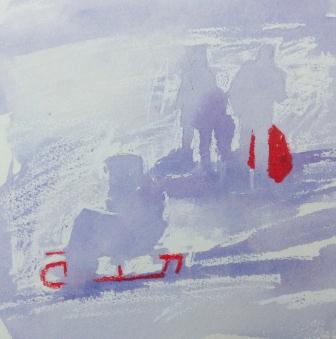
Back of Millfield Terrace in Winter, watercolour and acrylic ink (sepia), on Strathmore Gemini 500 638gsm paper, (18x28cm)
Strathmore is an American manufacturer of a range of different papers, including watercolour sheets of various weights and surface, cartridge, charcoal and drawing papers and an array of sketchbooks.
Discover more as Haidee-Jo Summers tests the Strathmore 500 Series watercolour papers.
Sometimes we artists can become a bit set in our ways, so to guard against this I always relish the opportunity to try something new.
In this instance it was a watercolour paper manufactured by Strathmore, which I hadn’t come across before.
The paper

The particular paper I was keen to try was their top-of-the-range series Gemini 500.
Top features:
- Made on a cylinder mould machine
- Contains 100 per cent cotton with four deckle edges on a full-sized sheet 22x30in (56x76cm).
- Available in two weights, 300gsm or a heavyweight 638gsm
- Finished to give a pleasing Not surface
- No optical brighteners are added to the pulp so the paper is a soft warm white
I used the sturdy 638gsm paper which was reassuringly stiff and certainly didn’t need to be stretched.
I would be just as happy to buy the less expensive 300gsm weight and stretch it to a board as I love a completely flat surface that won’t move around.
Testing watercolour painting techniques
1. Wet-into-wet
The first technique I wanted to try was a traditional wet-into-wet watercolour wash, so I flooded water generously over the surface to start with.
I then brushed and dripped warm yellows and reds onto the wet paper, which softened and melded together in a glorious fashion, as you would expect with a quality paper surface.
After several wet-on-dry washes of colour I started to apply creamy gouache paint, which also went on like a dream with the slightly rough paper texture creating a pleasing amount of drag or dry brush effect – but not too much.
2. Masking fluid
I next wanted to see how the paper handled masking fluid.
My students are often disappointed when the removal of masking fluid causes tears to the surface of their watercolour paper. I’m pleased to report I had no problems whatsoever with the Gemini.
Top tip
I would advise not to leave masking fluid on too long with any paper even one with good surface strength such as this.
Remove the masking fluid with a gentle rubbing motion as soon as you are able after the paint has fully dried.
3. Adding ink
Back of Millfield Terrace in Winter (see demonstration below) was painted using a limited palette of watercolours and sepia acrylic ink.
With this painting I used a brush with the ink but I also have drawn on the Strathmore paper with the ink dropper and a bamboo dip pen to great effect.
4. Wax resist
For further experimentation I thought I would try a wax resist effect so I used watercolours and oil pastels together on a little sketch of people sledging (see below).
Again the paper’s rough texture came up trumps with an attractive speckled effect produced by the wax resist.
Demonstration using wax resist technique on Strathmore 500

I first used white oil pastel with varying amounts of pressure for the snow areas around the figures, and a red oil pastel for the bright sledges, to create a wax resist

Sledgers, watercolour and oil pastel on Strathmore Gemini 500 638gsm paper, (22x22cm)
I then washed a mixture of ultramarine and a little crimson all over the piece. The wax resist produced an attractive speckled effect.
Haidee-Jo's top recommendations
The Strathmore 500 series papers are manufactured with cotton rag so you can safely expect quality, durability and strength.
I can recommend the heavyweight Gemini sheets for watercolour, ink, gouache and mixed-media work.
I also rather like the spiral hardbound Field Watercolour Sketchbook, which alternates a smooth 75gsm cartridge paper for drawing and/or writing notes with sheets of 300gsm watercolour paper.
The smaller 7x10in (18x25.5cm) book is a great size to pop in a rucksack for sketching trips.
Painting a snow scene on Strathmore 500
Stage one
I first sketched the subject lightly in pencil and then applied masking fluid to the lines of bright snow along the fences and rooftops.
I planned to flood ink on to the whole middle band of the painting as most of the subject was in shade, so reserving the small amounts of white first would give me the freedom to do that.
I then applied a warm wash of watercolour all over the sky and also on the foreground snow and the warm, lit glass of the greenhouses.
Stage two
![]()
I applied a diluted wash of sepia acrylic ink all over the buildings and middle distance in shade.
While this was still damp I added a blue and violet watercolour wash to the snowy roofs and the shadows of snow in the foreground.
Finished painting

Back of Millfield Terrace in Winter, watercolour and acrylic ink (sepia), on Strathmore Gemini 500 638gsm paper, (18x28cm)
When the last wash was dry I applied pure sepia ink with a brush for the darkest darks.
If you'd like to paint this snowy orchard scene on Strathmore 500 with Haidee-Jo

Orchard in snow, watercolour and gouache, (35 x 28 cms)
CLICK HERE FOR ANOTHER DEMONSTRATION
Read more about Haidee-Jo's work on her website www.haideejo.com, or read her blog here www.haideejo.blogspot.com












